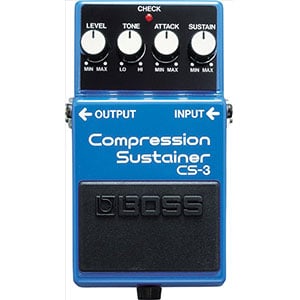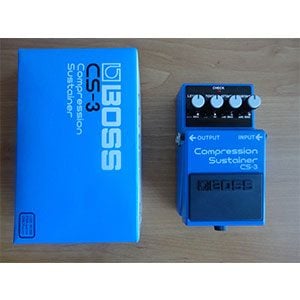- Home
- Instruments
- Gear
- Recording
- Lessons
- Reviews
- Blog


| Controls: |  |
| Features: |  |
| Performance: |  |
| Value: |  |
In many ways, Boss has attained a reputation of a trusty company that offers top-level mid-range items at a fair and affordable price, with renowned build quality, strong components and a sound worthy of players of every level. Well, that's a pretty good summary of their CS 3 compression pedal – a strong player worthy of your attention!
We took this fella out for a spin, and we can certainly say the device lived up to our expectations. Let's dissect it a bit now!
The pedal comes in the classic Boss metal casing – practical, easy to use, sturdy as a tank, and even nice-looking. It's a mono device with one input and one output, a LED status indicator and a large on/off foot-switch in the front. The tone is adjusted solely through four control knobs in the front.
What should be pointed out in here is that this is not just a compression pedal, but also a sustain device, allowing you to craft a variety of tones.
While we're at it, there's one thing worthy of noting here – compression and sustain effects are often criminally underrated among guitar players, especially newbies. They are seemingly subtle and don't perform any drastic changes to your sound (like wah-wah or distortion), but actually make a stellar difference.
Total weight 1 pound, total size 4 x 3 x 6 inches. One 9V battery or standard power adapter required.

As noted, we're looking at four basic knobs here. They're all fairly easy to understand, let's see what they do:
Level – As always, the Level knob controls the amount of effect that gets injected into your audio output. The more you increase it, the more compression effect and less clean guitar tone you'll get.
Tone – This knob controls the scope of tones that will get attacked by the effect. Adjust it based on sonic frequencies you want compressed.
Attack – This one adjusts the attack power of your picking or plucking. If you want your playing articulation to gain more prominence in the mix, crank this puppy up.
Sustain – The sustain feature adjust the length of the notes you play. Increasing this one leads to an increase of the whole signal tone.
The very essence of this pedal is that it cuts down your loud signals and frequencies while giving the lower ones a boost. This results in a well-rounded tone and enough versatility to shape up any type of guitar playing from clean light acoustic to full-blown distortion.
As for the down side, some users have reported minor hiss issues, so make sure to place this fella at the bottom of your pedal chain. Additionally, hooking the CS 3 up with a noise gate pedal will remove all the issues.
When all is said and calculated, this is a top value type of deal. The pedal offers a great bang for the buck and we thoroughly recommend giving it a spin. It falls into the medium quality range, and the price tag fits the device accordingly. Despite some minor issues, this is one of the best compression pedals for guitar a player can get. It will improve your entire tone, and that right there is this product's selling point. Thumbs up!
For more about the Boss CS 3, click here.
For more Compressor Pedals you Might like , click here.

Stephen says
I’ve used compressors since 1978. The CS-2 and CS-3 can make guitars sound great, whether clean or ODd. The only problem with this pedal is that it is very noisey compared with many other compressors. But it’s not too noisey, and the tones are worth it. COMPRESSORS ARE NOISY. They boost low signals, so hum and hiss are amplified. Compressors can take a while to learn how to use, but you can watch some YouTube videos about it. Once you get the hang of it, you won’t know how you ever did without it. You’d have to spend $200-$300 to get a better compressor than the CS -3.